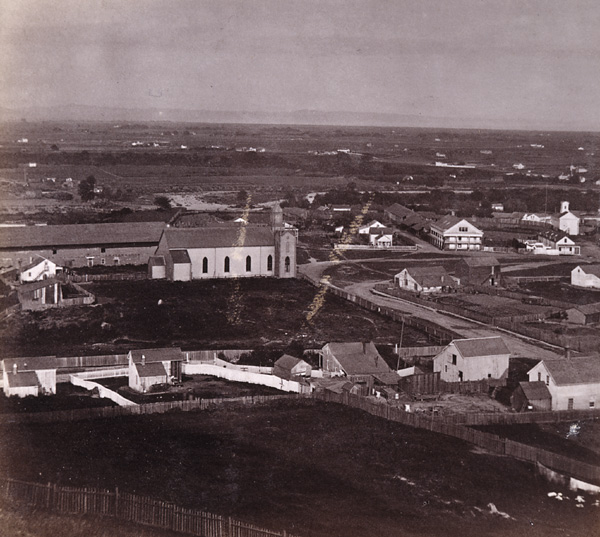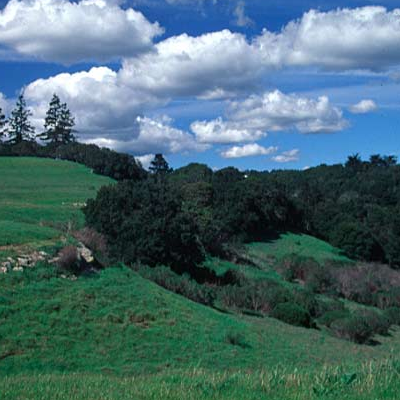History Pages: 14 - The County
For a table of contents, see History pages.
As mentioned previously, Santa Cruz (nee Branciforte) County was created in 1850. Elections followed shortly thereafter, and the first County officers took up their duties. Then, as now, getting elected was a sign that a person had achieved a certain level of recognition and reputation in the minds of fellow citizens. So it’s interesting to look back at those names. Not surprisingly, they were all Anglo-American men who arrived here during the 1840’s (Californios need not apply). Many of the names are already familiar to readers of this blog: Joseph L. Majors, William Blackburn, Elihu Anthony, John Daubenbiss, John Hames, Eli Moore.
We met William Blackburn previously as a California Battalion veteran and potato farmer, but history remembers him mainly as Judge Blackburn. After his military service and prior to his farming career, Blackburn was appointed alcalde in 1847, during the California Territory period. The office of alcalde was a holdover from the Spanish-style government, being a combination of administrator and judge. Blackburn became known as a dispenser of swift, decisive and sometimes Solomonic rulings. The alcalde’s offices and courtroom were in the juzgado, a 2 1/2-story adobe structure located where Holy Cross Elementary School stands today. Fans of old western movies will recognize the westernized version of the Spanish word: "hoosegow" (used to refer to a jail).
Santa Cruzans apparently liked Blackburn's judicial style, for they elected him as the first County judge in 1850. The first county-owned courthouse was a building built in 1849 by Thomas Fallon as a combination residence, hotel and saddlery shop. The new county bought it from Fallon in 1852 to be the first courthouse. (Chase, p.101-102). It stood at the northeast corner of the plaza, across School Street from the juzgado, where the 1/2 size Mission replica is today. To the north of that building, a small wooden County jail was later constructed.
One of the first County Supervisors, Eli Moore also deserves a little more attention. According to Clark, he was a native of Missouri who arrived here in 1847 and bought some ranch land from Jose Bolcoff. Also at some time during this early period, Moore briefly partnered with Bolcoff to operate the old Mission grist mill on Santa Cruz Creek (today's Babbling Brook Inn location on Laurel Street). Before long, however, Moore moved into town, building a log house that became only the second building (following Anthony's shop) in today’s downtown Santa Cruz. Moore later built a wood-frame house farther down Pacific. His family donated the first property to the City to form part of the site for the County's first courthouse, built in 1866.
Today’s Moore Creek flows through the old Moore ranch, and 246 acres of the former ranch land is now the Moore Creek Open Space Preserve, part of the city’s greenbelt. Downstream from the park, Moore creek was later dammed to form Antonelli Pond. Below the pond, the creek flows through Natural Bridges State Beach, where its riparian corridor creates a prime Monarch butterfly wintering site. There’s also a Moore Street, one block over from Majors Street in the Westlake neighborhood, but that was a different and later Moore - no relation.
Another of the first Supervisors was a man not yet mentioned: Moses Meder. Meder’s story is an interesting one. A native of New Hampshire, he arrived in Yerba Buena (San Francisco) on the ship Brooklyn in 1846 as part of the first group of Mormon settlers in California. Instead of staying with the group, however, Meder struck out on his own, ending up in Santa Cruz in 1847. He worked at Isaac Graham’s Zayante Creek sawmill for a while, and then built a new mill for Graham nearby on the San Lorenzo River. He profited enough from these labors to buy some land from Bolcoff, adjoining Moore’s ranch. Today’s Meder Street runs through the area. Appropriately, one entrance to the Moore Creek Preserve is from the west end of Meder Street.
Meder was apparently a man of honesty and integrity. One story tells how the first County Treasurer, Joseph Majors, faced a dilemma because the new county had no bank or other safe place to keep county funds. Majors’ solution was to ask his friend Meder to keep the money in a trunk under his bed.
Another interesting part of Meder’s story is that, late in his life, he donated land for a Jewish cemetery, on the condition that his family be given a burial plot in it (Meder himself is not buried there, so perhaps the land gift was part of his will). Meder was not Jewish, so this act of generosity is curious. The family plot is in the rear, separated from the Jewish cemetery. Meder’s earlier desertion of the Mormon settler party seems to indicate that he was not a strong Mormon, so his religious beliefs remain a mystery. As far as we know, there was no Mormon congregation in Santa Cruz during Meder's lifetime.

